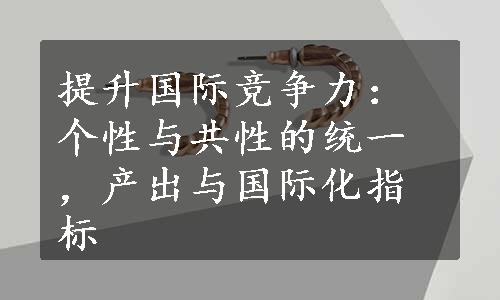
二、注重个性与共性的统一,侧重产出指标和国际化指标
研究型大学的国际竞争力中既有高等教育共性的部分,也有体现大学特色和优势的个性部分。因此,构建的国际竞争力指标体系也要坚持个性与共性相统一,不能因为过于注重共性追求而忽视特色建设,也不能因为过于保留特色而被排挤到高等教育体系边缘。研究型大学国际竞争力的指标体系的核心是评价和衡量研究型大学的国际竞争力,因此各类型指标均要与研究型大学的国际化相结合,将研究型大学放在全球层面、国际背景下进行比较。
【注释】
[1] Hazelkorn,E.,“The Impact of League Tables and Ranking Systems on Higher Education Decision Making,”Higher Education Management and Policy,2007,19(2),pp.87—110.
[2] OECD,“How Do Rankings Impact on Higher Education?”December 2007,Retrieved August 23,2009from:http://www.oecd.org/dataoecd/8/27/39802910.pdf.
[3] Dill,D.and Soo,M.,“Academic Quality,League Tables,and Public Policy:A Cross-national Analysis of University Ranking Systems,”Higher Education,2005,49(4),pp.495—533.
[4] 参见詹姆斯·费尔韦瑟:《论全球化背景下的大学知名度、学生研究及大学教学的相互关系》,载《北京大学教育评论》,2009,7(1),2~3页。
[5] Dill,D.,“Convergence and Diversity:The Role and Influence of University Rankings,”2006,pp.1—22,Retrieved March 15,2010from:http://www.unc.edu/ppaq/docs/Kassel_Paper_Final_US.pdf.
[6] Federkeil,G.,“Rankings and Quality Assurance in Higher Education,”Higher Education in Europe,2008,2(3),pp.219—231.
[7] “University of Aarhus Advances in Shanghai Ranking,”Retrieved July 2,2009from:http://www.au.dk/en/news/archive/2008/120808.
[8] Webster,T.J.,“A Principal Component Analysis of the U.S.News and World Report Tier Rankings of Colleges and Universities,”Economics of Education Review,2001,20(3),pp.235—244.
[9] Bogue,E.and Hall,K.,Quality and Accountability in Higher Education:Improving Policy,Enhancing Performance,United States of America,Praeger Publishers,2003,pp.51—73.
[10] Soo,M and Dill,D.D.,“The CHE University Ranking Germany,Public Policy for Academic Quality Research Program,”2007,Retrieved March 6,2010from:www.unc.edu/ppaq.
[11] Webster,T.J.,“A Principal Component Analysis of the U.S.News and World Report Tier Rankings of Colleges and Universities,”Economics of Education Review,2001,20(3),pp.235—244.⑤⑥ Salmi,J.and Saroyan,A.,“League Tables as Policy Instruments:Uses and Misuses,”Higher Education Management and Policy,2007,19(2),pp.31—68.
[12] Liu,N.C.and Cheng,Y.,“The Academic Ranking of World Universities—Methodologies and Problems,”Higher Education in Europe,2005,30(2),pp.127—136.
[13] 在2008年前称为《泰晤士报高等教育增刊》(Times Higher Education Supplement),后改名为《泰晤士报高等教育》。
[14] 参见贾永堂、沈红:《世界研究型大学形成与发展的特点及其对我国建设研究型大学的启示》,载《科技导报》,2003(2),31~35页。
[15] 参见刘念才、周玲:《面向创新型国家的研究型大学建设研究》,21页,北京,中国人民大学出版社,2007。
[16] 参见谢亚兰:《大学排名指标体系及影响研究》,上海交通大学博士学位论文,2010。(www.xing528.com)
[17] 参见曲绍卫:《大学竞争力研究——基于新制度经济学分析框架》,23页,北京,教育科学出版社,2008。
[18] “Berlin Principles on Ranking of Higher Education Institutions,”2006,Retrieved December 20,2008from:www.ihep.org/assets/files/□/a~f/BerlinPrinciplesRanking.pdf.
[19] Weert de,E.,and Boezerooy,P.,Higher Education in the Netherlands:Country Report,2007,见http://doc.utwente.nl/60259/.
[20] Deen,J.,Higher Education in Sweden:IHEM Country Report,2008,Retrieved March 8,2010from:http://doc.utwente.nl/60265/1/Kaiser07issues.pdf.
[21] Kaulisch,M.,and Huisman,J.,Higher Education in Germany,Country Report,CHEPS,2007,Retrieved March 8,2010from:http://doc.utwente.nl/60265/1/Kaiser07issues.pdf.
[22] Deen,J.,Higher Education in Sweden:IHEM Country Report,2007,from:http://doc.ut-wente.nl/60265/1/Kaiser07issues.pdf.
[23] 参见许庆豫、葛学敏:《国别高等教育制度研究》,117~119页,徐州,中国矿业大学出版社,2004。
[24] Salmi,J.,and Saroyan,A.,“League Tables as Policy Instruments:Uses and Misuses,”Higher Education Management and Policy,2007,19(2),pp.31—68.
[25] Liu,N.C,and Cheng,Y.,“Academic Ranking of World Universities,Methodologies and Problems,”Higher Education in Europe,2005,30(2),pp.127—136.
[26] Institute of Higher Education of Shanghai Jiao Tong University,Academic Ranking of World Universities,2003,Retrieved May 20,2008from:http://ed.sjtu.edu.cn/rank/2003/2003main.htm.
[27] http://www.webometrics.info/.
[28] Higher Education Evaluation and Accreditation Council of Taiwan,Performance Ranking of Scientific Papers for World Universities 2007,Retrieved December 20,2008from:http://ranking.heeact.edu.tw/en-us/2007/Page/Methodology.
[29] H指数是指研究者论文数量及其论文被引用的次数,常用于评估研究人员的学术产出数量与学术产出水平。
[30] http://rccse.whu.edu.cn/BigClass.asp?BName=大学评价andTemplate=1.
[31] Usher,A.,and Savino,M.,“A Global Survey of University Ranking and League Tables,”Higher Education in Europe,2007,32(1),pp.5—15.
[32] Dill,D.D.,and Soo,M.,“Academic Quality,League Tables,and Public Policy:A Cross National Analysis of University Ranking Systems,”Higher Education,2005,49(4),pp.495—533.
[33] Van Raan,A.,“Fatal Attraction:Conceptual and Methodological Problems in the Ranking of Universities by Bibliometric Methods,”Scientometrics,2005,62(1),pp.133—143.
[34] Marginson,S.,“Global University Rankings:Implications in General and for Australia,”Journal of Higher Education Policy and Management,2007,29(2),pp.131—142.
免责声明:以上内容源自网络,版权归原作者所有,如有侵犯您的原创版权请告知,我们将尽快删除相关内容。




